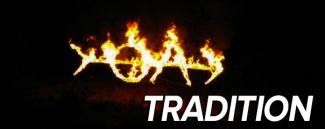
One lodge has been using rebar to add a unique flair to its ceremonies! Read about the origins of this tradition and the steps taken to design it.
Many Scouts love fire. Whether it is staring into a council fire at summer camp, lighting up a stove for dinner or the thrill of watching a spark slowly take hold, fire is a key part the outdoor experience upon which Scouting and our Order is based. Menawngihella Lodge, located in northern West Virginia, uses this fascination whenever it holds an event.
Lodge chief Larry Cogar says his lodge has used a large sign made of welded steel rebar at its council ring, which is then lit on fire, since the 1960s or ‘70s. The sign, a tradition unique to Menawngihella, sits across the lake from the ring where the lodge conducts its ceremonies, including calling out ceremonies and Vigil callouts, as well as camp ceremonies in which the OA is participating. Cogar said that it is an excellent way for the lodge to make its presence known throughout the camp.
The process of making the sign required a considerable amount of effort but has resulted in a product that has served the lodge well for almost 50 years. “The design itself was really simple,” Cogar said. “First, pieces were welded together to form the arrow shaft, then the tip and the fletchings were added, and next came the letters ‘O’ and ‘A.’ ‘A’ was an easy one as you just added two more pieces to the shaft. The ‘O’ took more diligent work.” Cogar remarked that what happened next resulting from taking two pieces to a metal machine shop in order to form a half circle sizing of the same degree on both pieces. Then, they were welded onto the shaft.
Lighting the sign on fire to achieve its distinctive look also requires a fairly involved process with multiple people. As Cogar described it, “The sign is a really hard material to prepare for use. First, you take burlap and cut it into strips about three inches wide and five feet long. Then, those strips are pre-soaked and then left to dry in the shade for 10-12 hours at the most. After this, you take the burlap strips and wrap the arrow. While you are doing this, another Scout is following behind you to wrap metal wire onto the frame to keep the burlap in place and secure it to the sign. It usually takes three people to light it properly, one in the center and two on the ends, so nothing burns out before another part is lit.”
The sign carries a lot of meaning for the Arrowmen of Menawngihella Lodge. Cogar cited its uniqueness as a major reason for its importance, noting that the sign and the practice of fire hooping, which involves dancing with hoops that are lit on fire, both lend a very special character to the lodge and its ceremonies. He also discussed the meaning based since the sign has been used for so long, and said that, above all, the sign serves to remind people that they are chosen for the Order of the Arrow.
Menawngihella Lodge’s fiery steel sign is a prime example of how lodges can give their ceremonies a unique flair that will touch and inspire Arrowmen for times to come. It also showcases the importance that unique and meaningful traditions, new or old, can have in shaping the identity of a lodge. Best of all, it appeals to a Scout’s desire to work in the outdoors with one of nature’s elements!